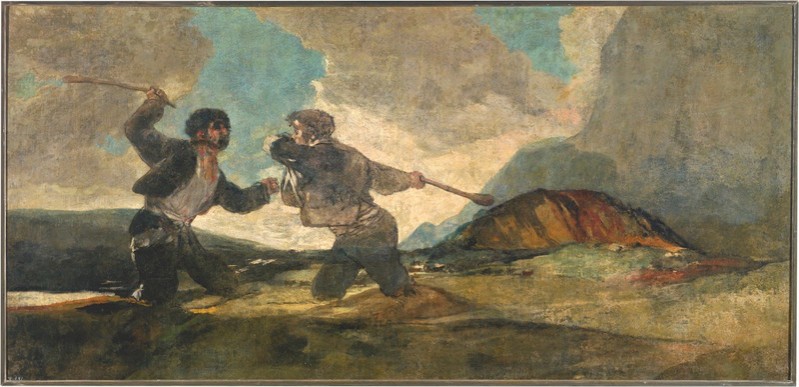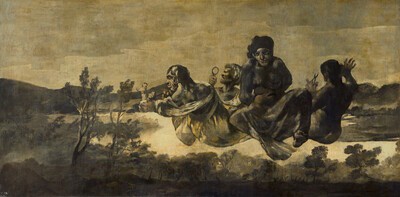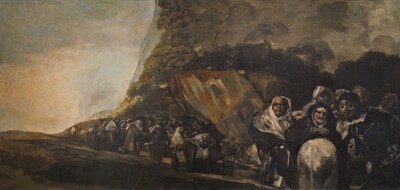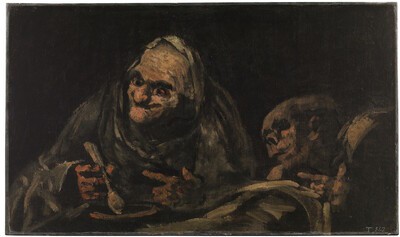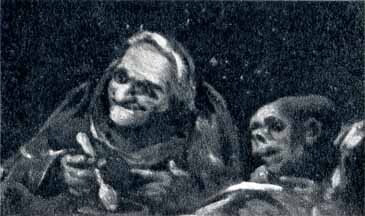- Cronología
- Ca. 1820 - 1823
- Ubicación
- The Prado National Museum. Madrid, Madrid, Spain
- Dimensiones
- 125 x 261 cm
- Técnica y soporte
- Oil painting on plaster transferred to canvas
- Reconocimiento de la autoría de Goya
- Undisputed work
- Titular
- El Prado National Museum
- Ficha: realización/revisión
- 27 Oct 2010 / 04 Mar 2024
- Inventario
- (P00758)
- Otros títulos:
-
The Strangers (Dos forasteros)
Two Men Fighting with Cudgels (Dos hombres riñendo a garrotazos)
Fight with Cudgels (Riña a garrotazos)
See Leocadia.
Brugada named this work Two Strangers, and Yriarte identified the main figures as provincial characters, calling them cowherds from Galicia: he understood the word "strangers" to mean from outside Madrid, from one of the furthest away corners of the peninsula. There are several slight variations on this title. The first is the most descriptive: Two Men Fighting with Cudgels (Dos hombres riñendo a garrotazos). This title was later shortened to Fight with Cudgels (Riña a garrotazos), and (possibly due to Salas' influence) Duel with Cudgels (Duelo a garrotazos).
This painting was located on the left-hand wall of the first floor of the house following The Fates (Las Parcas). The scene features two large-scale, almost monumental figures. The two men are shown at nightfall, trapped knee-deep in the ground, fighting with cudgels. The man on the left - who seems to be the stronger of the two - has blood on his face and chest, while the other raises his left arm to protect his face from his adversary's blow.
The figures are dressed according to Goya's times, their clothing contrasting with the blood that spurts from their injuries. The background is once more a landscape, with a hill that rises up on the right-hand side of the scene. It is striking that there are no fantasy elements to this painting, in contrast to the other murals located in the house.
Recent x-ray studies of the work and their comparison with photographs taken in the 19th century have revealed substantial changes in the scene followed its removal from the wall. The men were not originally buried in earth up to their knees; rather, as Yriarte described, they were shown on their feet in a meadow full of grass.
The first interpretations of the scene generally related it to the rural setting and brutal habits of country people.
The most common reading of the work makes reference to fights between brothers with allusions to Greek mythology, framed in the political context of Spain at the time the painting was produced.
Martínez Cubells also restored this work.
-
Pinturas Negras en la Exposición Universal de ParísPalacio del TrocaderoParís1878from may 20th to November 10th 1878
-
Goya. 250 AniversarioMuseo Nacional del PradoMadrid1996consultant editor Juan J. Luna. From March 29th to June 2nd 1996cat. 164
-
Vie et ouvre de Francisco de GoyaBibliography']['numberParísOffice du livre1970pp. 327-329, cat. 1616
-
Bibliography']['number
BarcelonaPolígrafa1970vol. I, p.379, cat. 709
-
Goya's Black Paintings: Truth and Reason in Light and LibertyBibliography']['numberNew YorkHispanic Society of America1984p. 94-101
-
Goya. 250 AniversarioBibliography']['numberMadridMuseo del Prado1996p. 31
-
Las pinturas negras de Goya, AlcobendasBibliography']['numberT.F. Editores1997p.79-80
-
Las Pinturas Negras de GoyaBibliography']['numberLondonScala Publishers Ltd.2003p. 81
